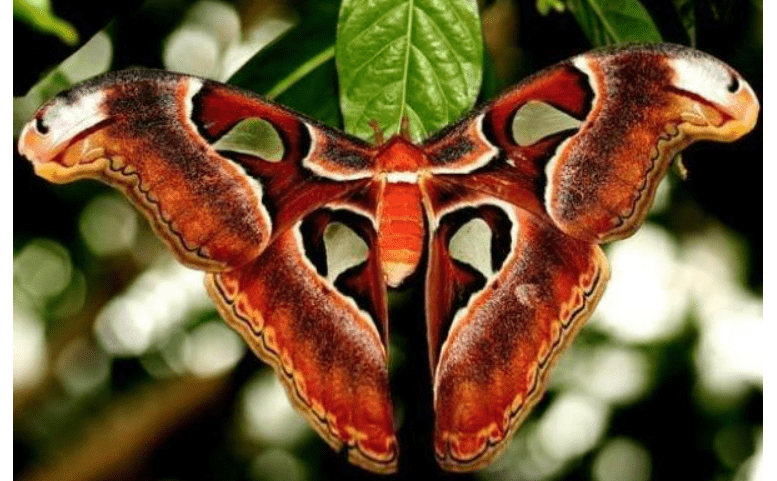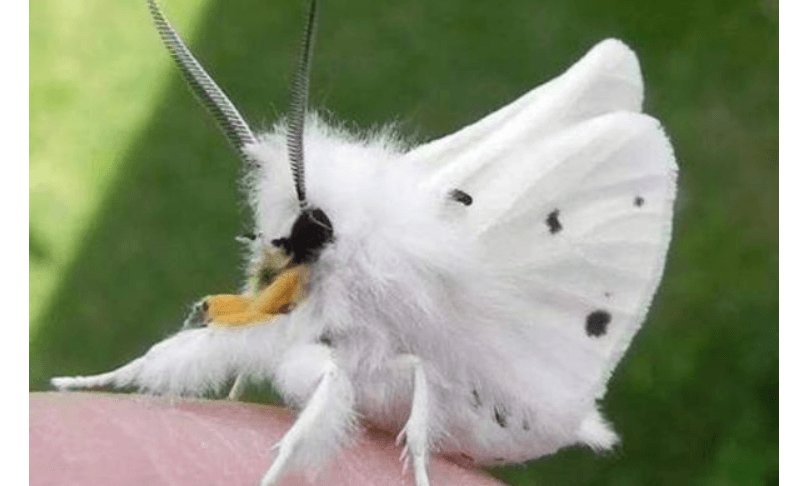Dry Leaf Butterfly: Its wings are like two dry leaves (considered a mimicry master in the butterfly world).
In nature, there are many organisms that mimic other things, and they often look even more realistic than the real thing. The dry leaf butterfly is one such organism. In a forest full of fallen leaves, the dry leaf butterfly is almost completely hidden. Its four wings look just like two dry leaves. Let’s explore what it really looks like together!
What does the dry leaf butterfly look like?

In the humid and hot tropical rainforest, you might suddenly see a dry leaf fluttering in the air. It’s actually a dry leaf butterfly, considered one of the most famous mimicry species in the butterfly world. Its body is almost identical to a tree leaf, just like a leaf insect. If you don’t look closely at its legs, you can’t tell the difference between it and a real dry leaf. Even the veins and broken marks of a dry leaf are perfectly replicated, making it a master of imitation in nature.
The habitat of the dry leaf butterfly

The dry leaf butterfly lives year-round in the central and southern regions of China, as well as in some areas and countries such as Myanmar, Thailand, and Nepal. Especially in the Emei Mountain of Sichuan and the Xishuangbanna area of Yunnan, China, there are more dry leaf butterflies. The dry leaf butterfly prefers to live in humid and hot rainforests and loves broad-leaved forest environments. Therefore, most of these butterflies live in areas with abundant rain and dense vegetation.
The behavior of the dry leaf butterfly

The dry leaf butterfly is very good at flying. Usually, because it lives in a tropical rainforest, it feeds mainly on rotting fruit and the sap of broad-leaved trees. Occasionally, it also feeds on some animal excrement. Therefore, it often stays on the ground covered with fallen leaves. However, because it looks so much like a dry leaf itself, it hardly moves once it stops, making it difficult for birds to spot it.
The breeding process of the dry leaf butterfly

The dry leaf butterfly has four main stages. After the female lays eggs, in about 4-6 days, the pupa will turn blackish green and grow more than ten ridges. It usually parasitizes on fallen leaves or rocks, and sometimes on plant roots. After hatching, the larva will eat the egg and start to gnaw on the back of the leaf, and will play dead when in danger.
Jichangweishuiqing moth: Thin and long tail like a ribbon (known as one of the most beautiful moths)
Although moths are considered ugly and bulky by most people, the Jichangweishuiqing moth has a fairy-like appearance with its wings being very distinctive. Its tail is very thin and long, like a ribbon of ancient goddesses, making it one of the most beautiful moths. Follow the exploration blog to take a closer look!
What does the Jichangweishuiqing moth look like?

The Jichangweishuiqing moth is a type of long-tailed green moth, with a very slender tail and a light green body. Its wings are translucent and very elegant in the sunlight. However, it also has unique features, such as the spiral-shaped end of its tail, which makes it even more beautiful. Its forewings also have dark stripes along the edges and four yellow-brown circular spots in the middle.
What are the habits of the Jichangweishuiqing moth?

Like most moths, the Jichangweishuiqing moth feeds on pine and maple trees, especially during the larval stage, causing more damage to these economic or greening trees. However, once it reaches adulthood, it stops feeding because its mouthparts degenerate. Therefore, after emerging from the cocoon, the Jichangweishuiqing moth can only survive for a week.
How does the Jichangweishuiqing moth reproduce?

Jichangweishuiqing moths usually emerge in April or May. They have dense fur on their heads, chests, and abdomens, and their antennae turn red, while their tails take on a swallow-like shape. The females secrete pheromones to attract males and then lay eggs behind leaves. Eventually, Jichangweishuiqing moth larvae are born.
What is the habitat of the Jichangweishuiqing moth?

The Jichangweishuiqing moth is also known as the “woodland long-tailed green moth” and mainly inhabits high-altitude mountainous areas. Like most moths, it exhibits typical phototaxis, but it is not as abundant as other moths, and its population is relatively small. Nevertheless, it is considered a precious species since it is not as large as other moths.
The Chinese oak silk moth: the largest moth in the world (with wing patterns resembling a snake’s head/able to intimidate birds)
Most moths are only the size of a thumb, but there are exceptions. The Chinese oak silk moth, as the largest moth in the world, is almost the size of an adult’s palm. It also has an extremely terrifying appearance, hence the nickname “snake head moth”. Let’s explore more about it together!
What does the Chinese oak silk moth look like?

The Chinese oak silk moth has very typical moth characteristics, such as feather-like antennae and a very plump abdomen. Its wings are also thicker and wider than those of butterflies. The female moths are especially large, with a body length of up to 20 centimeters. The most unique feature of the Chinese oak silk moth is the two protruding shapes on its wings, with eye-like patterns on them, hence its nickname “snake head moth”. These features are able to intimidate predators such as birds and protect itself.

The wing patterns of the Chinese oak silk moth are also very complex and gorgeous. Most of them are chestnut-colored, with a gradient of white on the outer lines of the fore and hind wings, and purple-red on the inside. There is a typical triangular transparent pattern in the center, which looks like a hollow. There is a slight difference in appearance between the male and female Chinese oak silk moths. The females are mostly duller and tend towards grayish-white, while the males tend towards reddish-brown.
What are the habits of the Chinese oak silk moth?

Like the Chinese moon moth, the mouthparts of the Chinese oak silk moth will gradually degenerate after adulthood, which means that their lifespan is not very long. During this time, they can hardly eat and can only rely on the fat in their bodies to maintain basic life activities. Therefore, most Chinese oak silk moths will die after only one week of adulthood. Generally speaking, females have more fat than males, so they live a little longer.
What is the breeding method of the Chinese oak silk moth?

The female Chinese oak silk moth passively waits for the male to approach. During the breeding season, the female moth secretes hormones to attract the male, which can float several kilometers away and be received by the male’s feather-like antennae. Eventually, they mate and lay eggs on the back of leaves. After about two weeks, the pupa hatches, and the larvae begin to eat leaves and gradually grow into adults
Fluttering Moths”: a colloquial term for moths in northern China (they make a fluttering sound while flying). “Fluttering Moths” is actually a general term used by the public for all moth species. Their wings usually flap faster and make a fluttering sound compared to butterflies, so people in northern China often jokingly refer to them as “Fluttering Moths”. Let’s explore the origin of this term together!
What are Fluttering Moths?

“Fluttering Moths” is actually a general term for moths, so all animals belonging to the Lepidoptera order of insects can be referred to as “Fluttering Moths”. The term “Fluttering Moths” is more commonly used by residents in northern China than in the south, as moths not only make a fluttering sound when flapping their wings, but also because the word “fluttering” in northern China carries the meaning of “big movements and excitement”, just like the way moths fly, making louder sounds than butterflies.
Is the powder on Fluttering Moths poisonous?

Fluttering Moths have a lot of scale-like powdery substance on their bodies, which falls off every time they fly. Some people may experience itching all over their bodies as a result of contact with this powder, but this is usually due to an allergic reaction rather than poisoning. Most moth powders are not toxic, but there are rare tropical rainforest moth species that are toxic and can even cause death. Therefore, it is important to identify the species of moth before coming into contact with it.
Do fluttering moths bite humans?

Fluttering moths do not bite humans. Most moth mouthparts are shaped like straws, and they primarily feed on plant sap, making it difficult for them to harm human skin. Even large moths like the Chinese Oak Silk Moth lose their mouthparts after adulthood and can only survive for about a week without being able to feed, relying only on stored fat.
“What do fluttering moths eat?”

As larvae, fluttering moths have chewing mouthparts and mainly feed on plant leaves, causing significant damage to plants. They tend to consume the leaves entirely, leaving only the veins. As adults, they either have degraded mouthparts or transform into straw-shaped mouthparts and primarily feed on plant sap, nectar, or other sugary liquids, causing less harm to plants.
Foot moth: the larval stage will bow forward (the body is like a ruler, so named)
I believe that many people are not familiar with the inch moth, and they are even more curious about the origin of its name. In fact, although it looks very mediocre as an adult, its unique behavior in the larval stage gave it its current name. It is said that there are actually a lot of this kind of moths in our country, so let’s take a look with Quest!
What does an inchworm look like

In fact, the inchworm is a general term for all inchworm insects. They each have their own appearance. For example, the wings of the silk hibiscus Venus inchworm are brown with tiny spots on them, which look very similar to dead leaves. One type of green-footed moth is green all over, with gray-brown spots, which completely simulates slightly withered leaves. That is to say, most of the moths evolve their appearance by simulating their own living environment.
What does an inchworm larva look like

Many people may be curious about how the inchworm got its name. In fact, it needs to be traced back to its larval state. It is said that the inchworm larva is called an inchworm. It does not wriggle slightly like other caterpillars, but bows its whole body Crawling forward like an arch bridge, it looks like a person is measuring something with his hand, which is similar to a ruler, so it is named the ruler moth, and this also makes its long legs only grow on the front and back of the body end.
Are moths poisonous?

Inch moths are basically non-toxic, especially the temperate-zone moths are mostly mild, and the powder on their wings is mostly non-toxic, but if they are large moths born in the tropical rainforest, they are very toxic, and even have Some moths can kill people, but the inchworm can only cause damage to wooden tables and chairs, and does not cause any harm to humans.
Are moths pests or beneficial insects?

The inchworm is a kind of pest, because they often eat up the leaves of the plants in the larval stage, and even kill the plants when they are the most serious, especially the sophora inchworm, which likes to eat classic green plants. Insects are even more destructive. In 1999, there was a large-scale event of vegetation destruction by the inchworm in our country, and the adult inchworm will be less harmful.
